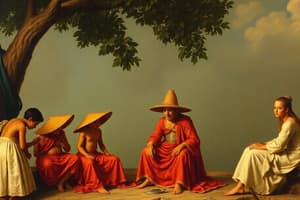Podcast
Questions and Answers
Who was Juan de Plasencia?
Who was Juan de Plasencia?
- A Spanish conquistador
- A historian from the 19th century
- A local Filipino leader
- A Franciscan friar and missionary (correct)
Juan de Plasencia was born in the 17th century.
Juan de Plasencia was born in the 17th century.
False (B)
What is the full title of Juan de Plasencia's book on Tagalog customs?
What is the full title of Juan de Plasencia's book on Tagalog customs?
Relacion de las Costumbres de los Tagalogs
Juan de Plasencia arrived in the Philippines on July 2, _____.
Juan de Plasencia arrived in the Philippines on July 2, _____.
Match the following events with their corresponding years:
Match the following events with their corresponding years:
What was one of the outcomes of Plasencia's book?
What was one of the outcomes of Plasencia's book?
Juan de Plasencia was honored with the title 'Venerable' for his contributions.
Juan de Plasencia was honored with the title 'Venerable' for his contributions.
In which part of the Philippines did Juan de Plasencia do most of his missionary work?
In which part of the Philippines did Juan de Plasencia do most of his missionary work?
Juan de Plasencia died in _____, Laguna in 1590.
Juan de Plasencia died in _____, Laguna in 1590.
What lifestyle did Juan de Plasencia aim to lead to connect with people?
What lifestyle did Juan de Plasencia aim to lead to connect with people?
Flashcards are hidden until you start studying
Study Notes
Key Terms
- Customs: Defines regular, patterned behaviors characteristic of social life within a community.
- Juan de Plasencia: Spanish Franciscan friar and early missionary in the Philippines, influential in documenting local customs.
- Tagalog(s): Indigenous people originally from central Luzon in the Philippines.
- Relacion de las Costumbres de los Tagalogs: Book by de Plasencia detailing the customs of the Tagalos published in 1589.
Juan de Plasencia
- Born as Joan de Portocerra in Extremadura, Spain, in the 16th century during the Golden Age (Siglo de Oro).
- One of the seven children of Pedro Portocarrero.
- Arrived in the Philippines as part of a Franciscan missionary group on July 2, 1578.
Timeline of Significant Events
- 1521: First arrival of Spaniards in the Philippines.
- 1565: Establishment of a colonial government in Cebu led by Miguel Lopez de Legazpi.
- 1571: Relocation of the government seat to Manila, fully established in Intramuros by 1574.
- 1896: Beginning of Asia's first nationalist revolution with the discovery of the Katipunan, led by Andres Bonifacio.
- 1896: Formal declaration of Philippine independence.
Relaciones de las Costumbres de los Tagalogs (1589)
- Aimed to document and preserve the traditional lifestyles of local populations while introducing the first form of civil code for local governance.
- Illustrated the political, social, economic, and cultural structures of Filipino communities prior to Spanish colonization.
- De Plasencia's missionary approach emphasized living simply to engage closely with the people he sought to convert to Christianity.
- Promoted understanding of Catholic teachings to foster genuine acceptance of the faith among the locals.
- Honored posthumously by the Franciscan order with the title "Venerable"; passed away in Liliw, Laguna, in 1590.
Studying That Suits You
Use AI to generate personalized quizzes and flashcards to suit your learning preferences.




